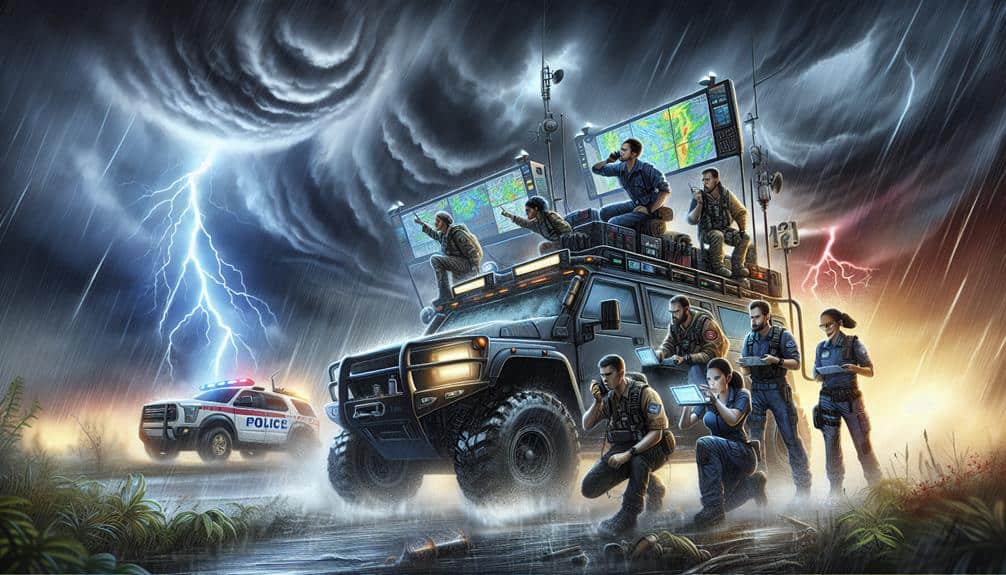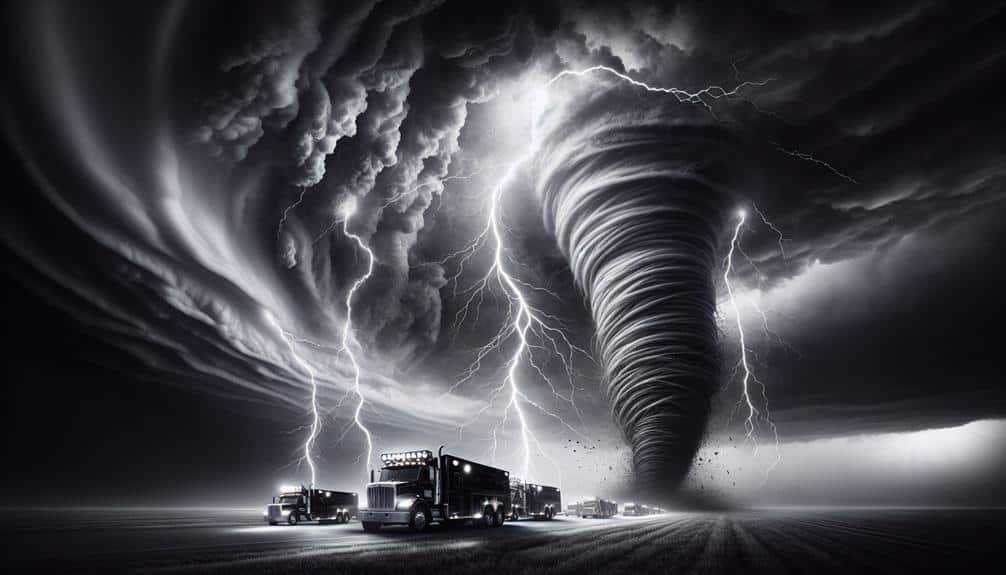Our storm chaser communication strategy integrates two-way radios for instant coordination and satellite phones as fail-safes for areas with no cellular service. We utilize real-time data apps to access radar imagery and storm tracks, enhancing operational efficiency. Cutting-edge weather tech, like Doppler radar and satellite tracking, offers both macro and micro-level storm insights. By standardizing communication protocols and using encrypted channels, we maintain data security and operational integrity. Centralized command hubs, paired with GPS and real-time data analytics, optimize team coordination and dynamic role assignments. To explore further into our tactical methodologies, continue following.
Key Points
- Two-way radios enable instant, real-time coordination and communication between storm chasing team members.
- Satellite phones provide reliable backup communication in areas with failed cellular networks.
- Real-time data apps supply radar imagery, storm tracks, and satellite tracking information for immediate analysis.
- Encrypted communication channels ensure secure, uninterrupted information flow among team members.
Essential Communication Tools
We rely on a suite of essential communication tools, including two-way radios, satellite phones, and real-time data apps, to guarantee timely and accurate information exchange during storm chasing operations. Effective communication is critical to our safety and success, and each tool plays an essential role.
Two-way radios provide instant radio communication between team members, allowing us to coordinate movements and share observations in real-time without delay. This is important when traversing rapidly changing weather conditions.
Satellite phones serve as a reliable backup when cellular networks fail, ensuring we remain connected even in remote areas. By maintaining a constant line of communication, we can relay crucial information back to our base and receive updates on storm development.
Real-time data apps integrate seamlessly with our other tools, offering immediate access to radar imagery, storm tracks, and satellite tracking information. This data-driven approach allows us to make informed decisions quickly, optimizing our positioning and response strategies.
The combination of these technologies enhances our operational efficiency and safety, enabling us to chase storms effectively while maintaining the freedom to adapt to dynamic environments. In storm chasing, precision and reliability in communication aren't just advantages—they're necessities.
Utilizing Weather Technology
Leveraging cutting-edge weather technology allows us to access precise meteorological data, enhancing our ability to predict and react to severe storm developments. By integrating satellite tracking and radar analysis, we can monitor storm systems in real-time, enabling quick decision-making that can make the difference between safety and disaster.
Satellite tracking offers a macro-level view, capturing large-scale atmospheric conditions and providing vital data on storm formation and movement. High-resolution satellite imagery lets us identify potential storm cells before they reach critical stages. This proactive approach is necessary for forecasting and issuing timely warnings.
Radar analysis, on the other hand, delivers micro-level insights by tracking precipitation intensity, wind velocity, and storm structure. Doppler radar technology allows us to detect rotational patterns within storms, which is essential for identifying tornadoes and other severe weather phenomena. By examining radar signatures, we can estimate the storm's path and potential impact zones with high accuracy.
Both these technologies, when used in tandem, provide a thorough understanding of storm dynamics. By continuously updating our data feeds, we maintain the freedom to adapt our strategies in real-time, ensuring that we stay ahead of the storm and safeguard our operations.
Team Coordination Methods
Effective team coordination hinges on clear communication protocols and the strategic use of collaboration tools to guarantee smooth information flow during storm tracking operations. We rely heavily on standardized communication signals to make certain that every team member is on the same page. These signals, often pre-defined and tested during drills, allow us to relay important information quickly and accurately, minimizing the risk of misinterpretation under high-pressure conditions.
Incorporating advanced GPS and real-time data analytics, we optimize team logistics by pre-assigning roles based on each member's expertise and current location relative to the storm. This dynamic role assignment enables swift response and flexibility, essential for adapting to rapidly changing weather patterns. Our team benefits from a centralized command hub where data from various sources converge, and decisions are made based on detailed situational awareness.
Additionally, we use encrypted communication channels to maintain the integrity of our signals, ensuring that critical information remains secure and accessible only to team members. By integrating these methods, we enhance our operational efficiency and uphold the freedom to make informed decisions in real-time, ultimately leading to more efficient storm tracking and higher safety standards for our team.
Data Sharing Protocols
To maintain the integrity and accuracy of our storm tracking operations, our data sharing protocols implement real-time synchronization across all devices and team members. We leverage cloud-based platforms to ensure instant information sharing, which facilitates dynamic decision-making. By synchronizing GPS coordinates, radar data, and meteorological readings, all team members receive consistent updates, thereby reducing delays in our responses.
Data security is paramount in our operations. We utilize end-to-end encryption to safeguard the sensitive information we gather and share. This includes implementing multi-factor authentication and regularly updating our security protocols to mitigate any potential breaches. Our approach guarantees that only authorized personnel can access the data, maintaining the confidentiality and integrity of our information.
Analyzing data from multiple sources allows us to create a thorough and real-time situational awareness. We integrate satellite imagery, storm models, and field reports into a unified system. This robust data amalgamation empowers us to make precise predictions and optimize our tracking strategies.
Our data sharing protocols also involve automated alerts and notifications, guaranteeing that all team members are promptly informed of any critical changes. These measures foster a collaborative environment where accurate, secure, and timely information sharing drives our storm chasing endeavors.
Emergency Response Plans

When severe weather conditions threaten, our emergency response plans activate a series of predefined protocols to safeguard the safety and efficiency of our storm chasing operations. We rely on data-driven decisions and real-time monitoring to execute these plans effectively.
Key elements include:
- Response Coordination: We establish a centralized command structure to streamline decision-making processes and guarantee all team members receive clear, consistent directives. This enhances our ability to adapt quickly to changing conditions.
- Rapid Communication: Using advanced communication tools, we maintain constant contact with our field teams. This secures that critical information is disseminated without delay, allowing for immediate adjustments to our operations based on real-time data.
- Resource Allocation: We pre-position equipment and personnel in strategic locations based on predictive models. This proactive approach minimizes response times and maximizes our operational coverage.
- Safety Protocols: We implement stringent safety measures, including predefined evacuation routes and emergency shelters. These protocols are regularly reviewed and updated to align with the latest meteorological insights and technologies.
Frequently Asked Questions
How Do Storm Chasers Stay Safe During Extreme Weather Conditions?
We prioritize safety protocols by constantly monitoring weather data and employing emergency equipment. This approach allows us to make informed decisions, ensuring our freedom to chase storms while minimizing risks during extreme weather conditions.
What Training Is Required to Become a Storm Chaser?
Ironically, becoming a storm chaser requires more than just loving danger. We undergo intense preparation and hands-on experience, including meteorology courses and field training, ensuring we're ready to face extreme weather while maintaining our freedom to explore.
How Do Storm Chasers Fund Their Expeditions?
To fund our expeditions, we rely on diverse funding sources and partnerships. Sponsorship opportunities and crowdfunding also play critical roles. Analyzing data, we find these methods maximize financial freedom, ensuring successful storm chases.
What Are the Psychological Challenges Faced by Storm Chasers?
It's common knowledge that 80% of storm chasers report high anxiety levels. Managing mental health is essential for handling stress. We utilize mindfulness techniques and support networks to maintain focus and freedom during high-stress situations.
How Do Storm Chasers Contribute to Public Weather Awareness?
We enhance public education and weather tracking by providing accurate data. Our community engagement efforts boost emergency response, ensuring people are well-prepared. This analytical approach empowers communities to make informed decisions and maintain their freedom.
